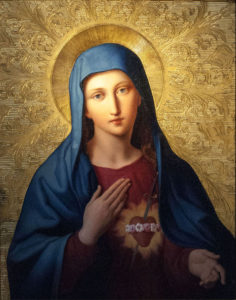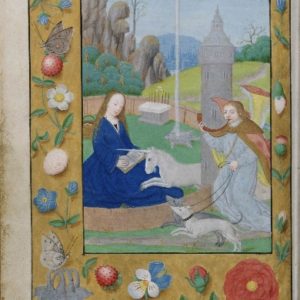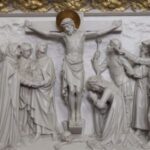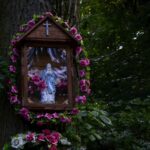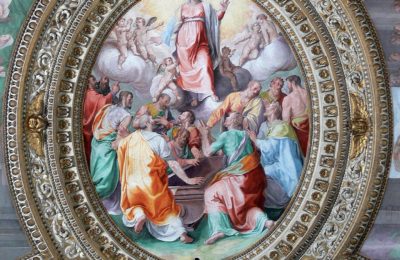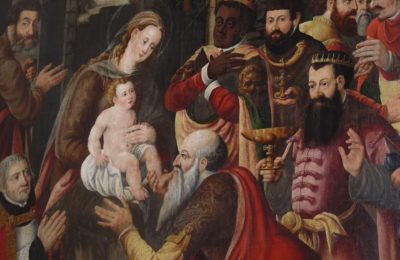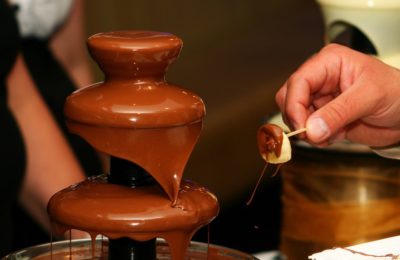“Let us transport ourselves in spirit to the holy mountain of Calvary,
to the foot of the cross, beside Mary… She practices there an unalter-
able patience. She stands up in the midst of the horrible tempest like
a rock surrounded by waves, which beat against it without causing it
to fall. Neither the abyss into which she is plunged by her grief, nor
the spectacle of death, nor the fury of man, nor the rage of demons is
able to cast her down. Her demeanor is full of resolution and courage.
Without allowing a complaint to escape her, she adores the designs of
God in silence and submits to them. Let us look at ourselves in this
beautiful mirror of patience, and let us be confounded. It requires so
little to cast us down, to make us lose heart, to excite complaints and
murmurings!
The humility of Mary is here equal to her patience. A mother
whose son is suffering capital punishment is ashamed to show her-
self; she is afraid lest the ignominy of her son should rebound upon
her, and she hides herself; but Mary shows herself and shows herself
even at the foot of the cross (Jn 19:25). It is there she awaits all the
contempt, all the insults that can be heaped upon her, and is happy to
be able to taste with Jesus the chalice of humiliation and to drink it
down to the dregs. What a lesson for us!
Mary teaches us the spirit of sacrifice. Knowing that the design
of God is that Jesus should die to save the world, she enters with her whole soul into the divine decrees…What a sublime example of the spirit of sacrifice!
~Fr. André Jean M. Hamon (d. 1874)– French Sulpician professor of dogmatics and author of several spiritual and historical works.” (source, Benedictus, The Traditional Catholic Companion, Sophia Institute Press)
“There is never a crack in the ivory tower Or a hinge to groan in the house of gold Or a leaf of the rose in the wind to wither And she grows young as the world grows old. A Woman clothed with the sun returning to clothe the sun when the sun is cold.” ~G.K. Chesterton, excerpt from The Towers of Time*
One of the titles of the Blessed Virgin Mary is Tower of Ivory. What does it mean that Our Lady has been referred to as thus? Blessed John Henry Newman (b. 1801- d. 1890) wrote a short piece on this topic; and that is the subject of today’s post: Our Lady as the Tower of Ivory. Fr. Newman wrote:
Mary is the “Turris Eburnea,” the Ivory Tower A tower is a fabric which rises higher and more conspicuous than other objects in its neighbourhood. Thus, when we say a man “towers” over his fellows, we mean to signify that they look small in comparison of him.This quality of greatness is instanced in the Blessed Virgin. Though she suffered more keen and intimate anguish at our Lord’s Passion and Crucifixion than any of the Apostles by reason of her being His Mother, yet consider how much more noble (emphasis added by SCF) she was amid her deep distress than they were. When our Lord underwent His agony, they slept for sorrow. They could not wrestle with their deep disappointment and despondency; they could not master it; it confused, numbed, and overcame their senses. And soon after, when St. Peter was asked by bystanders whether he was not one of our Lord’s disciples, he denied it. Nor was he alone in this cowardice. The Apostles, one and all, forsook our Lord and fled, though St. John returned. Nay, still further, they even lost faith in Him, and thought all the great expectations which He had raised in them had ended in a failure. How different this even from the brave conduct of St. Mary Magdalen! and still more from that of the Virgin Mother! It is expressly noted of her that she stood by the Cross. She did not grovel in the dust, but stood upright to receive the blows, the stabs, which the long Passion of her Son inflicted upon her every moment. In this magnanimity and generosity in suffering she is, as compared with the Apostles, fitly imaged as a Tower. But towers, it may be said, are huge, rough, heavy, obtrusive, graceless structures, for the purposes of war, not of peace; with nothing of the beautifulness, refinement, and finish which are conspicuous in Mary. It is true: therefore she is called the Tower of Ivory, to suggest to us, by the brightness, purity, and exquisiteness of that material, how transcendent is the loveliness and the gentleness of the Mother of God. (end of Newman piece)Fr. Newman makes this point:
“It is expressly noted of her that she stood by the Cross. She did not grovel in the dust, but stood upright to receive the blows, the stabs, which the long Passion of her Son inflicted upon her every moment.”This expresses, with Scriptural back up, that Our Lady stood at the Cross. I have seen art that depicts Our Lady as kneeling at the Crucifixion. Such depictions are simply wrong, and (attempt to) destroy the idea of her, which Catholics have long held, as the Tower of Ivory. However, the truth prevails: our Mother is the Tower of Ivory, and she stood at the Cross. She was noble in all of her actions; even amidst the sorrows she bore at the Cross, and on this day, Holy Saturday.
